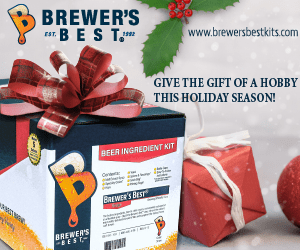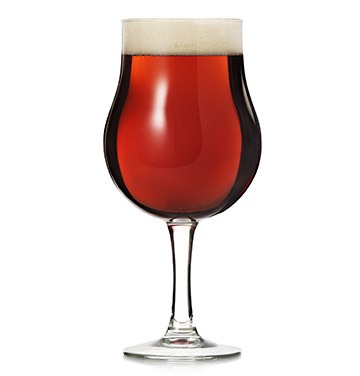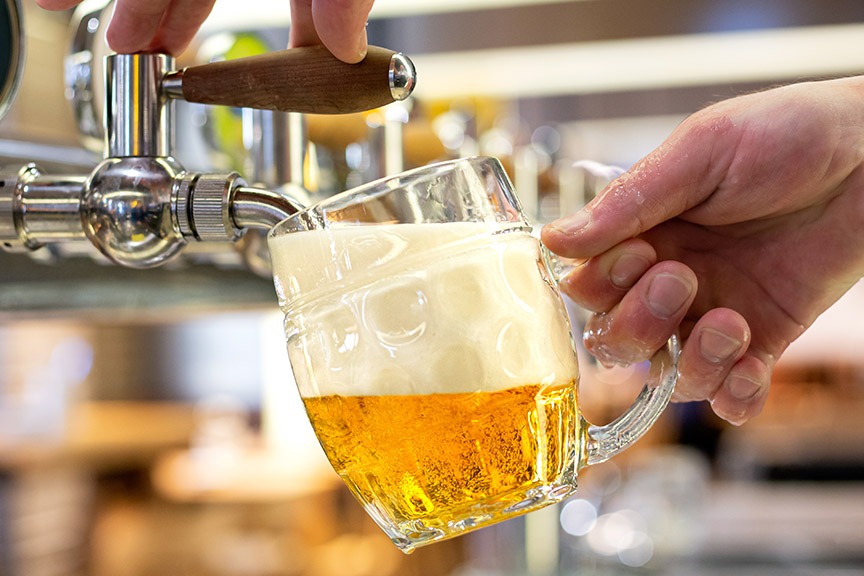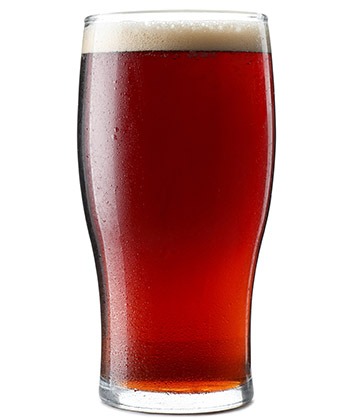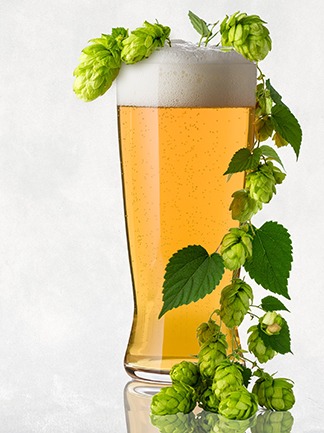Brown ale is not easy to define in terms of its being a style. It was for centuries the most common form of beer, in Europe as well as Britain, since until fairly late in the 18th Century it was difficult and expensive to make pale malt. As a result, virtually all beers were brown, no matter how they were hopped or how strong they were. Other beers became distinct styles — such as pale ales, porter (itself really a brown ale) and mild ale — but nothing emerged that was specifically called brown ale until the very early 20th Century, when Mann’s introduced its now-famous low-gravity beer of that name. This was followed some 25 years later when Newcastle Brown Ale came on the market, at a significantly higher original gravity.
Other brewers tried to get into the market by bottling their mild ale under the name brown ale, making mild itself a brown ale, in retrospect. Yet others produced brown ales over quite a range of gravities, before the style went into almost terminal decline, as did mild in Britain. Then, of course, at the end of the 20th Century, American micros got into the act and re-invented brown ale. American browns were generally bigger and hoppier than any of the extant British versions. So now we have not one but three types listed by Beer Judge Certification Program (BJCP), namely, Southern English, Northern English and American Brown Ale!
In this article, I will discuss the two English examples.
Style Notes
I have given a range of parameters for Southern brown ale, but there is really only one commercial example of any note and that is Mann’s Brown Ale. This comes in at 2.8% ABV, around 1.033 OG. It was brewed in East London, by Mann Crossman Paulin (a company with a Putney brewery just 20 yards from where my father was born, which may have something to do with my lifelong interest in beer and brewing!). The company was taken over by Watney’s in 1958, forming the giant Watney Mann Company. The East London Brewery was soon closed and Mann’s Brown Ale was brewed at various sites around the country. It ended up in the hands of Refresh UK and is currently brewed at Burtonwood in Cheshire, ironically in the Northwest of England.
Mann’s Brown Ale is a dark-brown, predominantly sweet, bottled beer; it was created as such and was never simply a bottling of draught mild ale. When it was first produced, it was advertised as “the sweetest beer in London.” With the rise in popularity of dry, hoppy, pale ales, it is hardly surprising that such a sweet beer should have only a niche market today. But, there is more to it than just sweetness, for with its relatively full palate and a hint of roast malt, it is still quite complex for a low-gravity session beer.
There are several extant examples of Northern brown ale, such as Samuel Smith’s Nut Brown Ale, and, of course, Newcastle Brown Ale. The latter was first brewed in 1927, and is undoubtedly the leader in this field today. Northern Brown Ales are quite different from the Southern version, being stronger, paler, drier, and with a definite (though not marked) hop bitterness. Newcastle Brown is sold in bottle and also on draught, though not in a cask-conditioned form.
The beer had the distinction of obtaining a Protected Geographical Indication from The European Union in 2000, meaning that it could only be produced in Newcastle, and not otherwise imitated. Unfortunately, the brewers, Scottish and Newcastle — the only remaining British-owned major brewery in Britain! — have now relinquished this distinction, having closed the Tyne brewery in Newcastle in favor of another brewery some distance outside of the city. Another interesting fact is that the man who developed Newcastle Brown, actually started work at the Tyne Brewery because it was run by no less than Thomas Watson Lovibond, inventor of the eponymous color scale!
Southern Brown Malts
The base malt for a Southern brown ale can be English pale, or US 2-row, although English mild ale malt is preferable. The original, Mann’s Brown Ale, also used a small proportion of wheat (10% of the total grist) and, more importantly, roasted barley for flavor and color. For extract brewers, ignore the wheat, go with a pale extract and steep some roast barley if you want to get close to Mann’s version. I would also suggest that both extract and all-grain brewers should use a high color crystal malt (120 °L), at the rate of up to 1.0 lb. (0.45 kg) per 5-gallon (19-L) brew. This will add some needed sweetness to the beer, as well as color.
In the New Haven, Connecticut brewpub, BruRm @Bar, we recently brewed a version of Southern brown ale, in which we departed from these basic rules, although our aim was to produce a beer which met the style in terms of flavor. This used a grist made up of equal amounts of pale and brown malts, along with 3% oats, 9% Belgian biscuit and 5% dark crystal malt (120 °L). The use of brown malt takes this beer back closer to the roots of brown ale, and adds its own unique flavor, while the other malts and the oats add complexity and contribute to sweetness. This beer, called Heavy Hand Hank, weighed in at an original gravity of 1.041 (10.2 °P), but finished at 1.017 (4.3 °P), making it around 3.1 % ABV. (See the recipe on page 27.)
You need to mash at relatively high infusion mash temperatures (around 154–155 °F/67.8–68.3 °C) to ensure the required residual sweetness. This is particularly essential if you want to go the authentic route and roast barley is your only roasted malt. Extract brewers might want to add some maltodextrin, depending upon what final gravity your sample of extract will give.
Northern Brown Ale Malts
English Pale malt, or US 2-row pale, serve as the main source of fermentables, but again, a mild malt is preferable. Newcastle Brown is paler and drier than the Southern version, and uses only crystal malt with the pale malt base. With most of the color coming from the crystal, it should be dark, 80 °L, or preferably 120 °L, at 1⁄2 to 1.0 lb. (0.23–0.45 kg) per 5 gallons (19 L). Mashing is typically carried out at 150–152 °F (65.6–66.7 °C). If you want to move to a darker, slightly more complex version of brown ale, you can also add a little roasted barley (up to 4 oz./113 g in 5 gallons/19 L), as does Samuel Smith’s in their Nut Brown Ale. A good variation in my book is to use an equal amount of chocolate malt in place of the roast barley.
Extract brewers will find the best approach is to use a light extract, along with some steeped dark crystal malt. Again, if you want to move away from the (relatively) paler color of Newcastle Brown, try a brown ale extract (though there are only a couple on the market). Perhaps better, though, is to go with the amber extract, and as for the all-grain brew, steep up to 4 oz. (113 g) roast barley or chocolate malt along with the crystal malt.
Hops
Commercial examples of these beers have only low levels of bitterness and virtually no hop character or aroma. The classic English Fuggles (my favorite) and Goldings are just right for these beers, though Target, Willamette, Liberty and Northern Brewer all give good results. If you are just going for bitterness, then add all the hops at the start of the boil. However, it is very easy for these beers to appear one-dimensional, and I consider that they benefit from a little more bitterness than the originals, and also from having some noticeable hop character. For the latter, just add 0.5–1.0 oz. (14–28 g) of the above varieties per 5 gallons (19 L) of wort at the end of the boil.
Water
Southern brown ale is really a London beer and so was traditionally made from relatively calcium-poor water, with significant carbonate content. Therefore, you might add up to 1 tsp. per 5 gallons (19 L) of calcium carbonate to your mash if you have very soft water. Northern Brown Ale, in contrast, is generally brewed with moderately hard water, low in carbonates.
As usual, for extract beers, there is no need to treat the water, as this has been done by the extract manufacturer.
Brown Ale Yeast
The standard English Ale yeasts will all work reasonably well for the Southern brown style, but there are a couple of things to look out for. The sweetness comes from using a relatively high mash temperature (plus the fact that low-enzyme English malts are used), but the brewers “hold” this sweetness by pasteurizing the beer in the bottle. You cannot, of course, do this at home, and you should therefore look for a highly flocculant yeast that produces a low level of apparent attenuation.
Wyeast 1028 (London Ale) fits this bill nicely and White Labs WLP013 (London Ale) would be good, too. It would be best to go for a relatively low fermentation temperature — say around 65 °F (18 °C), and dropping it down to 50 °F (10 °C) once the primary fermentation is finished — if you have the ability to do so.
Northern brown ale is of a higher gravity than its Southern cousin, and is not meant to be as sweet. However, there is another consideration; Newcastle Brown, and a rival Double Maxim (also from the Northeast of England), both have a definite fruity character, from esters produced during fermentation. White Labs WLP023 (Burton Ale) yeast will do this admirably, as will Wyeast 1084 (Irish Ale). In this case, ferment at around 70 °F (21 °C), so as to encourage ester formation. Note that, according to Michael Jackson, Newcastle Brown is actually a blend of two different beers, one weaker and one higher in gravity than that of the finished product. This permits the brewers to achieve a higher level of esters than if the beer were brewed at working gravity.
Conclusion
It could be argued that both types of Brown Ale are quite modest, gentle beers, not particularly noted for either big flavors, or for complexity. That is not necessarily a disadvantage, for these are meant to be session beers (especially the Southern version).
Besides, I have tried to show you how you can give this style a little extra interest, without reducing drinkability. I can tell you we had no problem in selling Heavy Hand Hank to the sophisticated Yale crowd!
Don’t forget, before we had all the plethora of styles available today, we had only Brown Ale. In that sense Brown Ale is the Mother and Father of them all. So get started on your’s today!
Southern Brown Ale — A Man’s Beer
(5 gallons/19 L, all-grain)
OG = 1.033 FG = 1.011
IBU = 22 SRM = 33 ABV = 2.8%
Ingredients
5.5 lb. (2.5 kg) mild ale malt
12 oz. (0.34 kg) wheat malt
10 oz. (0.28 kg) crystal malt (120 °L)
2.0 oz. (57 g) roast barley
6 AAU Fuggles hops (90 mins) (1.5 oz./42 g at 4.0% alpha acids)
Wyeast 1028 (London Ale) yeast
1⁄2 cup dried malt extract (for priming)
Step by Step
Use a single-step infusion mash at (around 154–155 °F/67.8–68.3 °C) for 1–1.5 hours. Sparge one hour, with water no hotter than 175 °F (80 °C), until run-off reaches SG 1.010–1.012. Boil 90 minutes, with bittering hops added at the start. Strain, or siphon off from the hops, and adjust wort volume with cold water, and cool to about 70 °F (21 °C). Pitch with yeast starter, and allow to ferment. By 5–7 days, final gravity should have been reached; rack into a glass fermenter. One week later, rack again, prime with DME, and rack into keg or bottles.
Southern Brown Ale — The Little Londoner
(5 gallons/19 L, extract w/ grains)
OG = 1.034 FG = 1.011–1.012
IBU = 24 SRM = 33 ABV = 2.8%
Ingredients
4 lb. 4 oz (1.9 kg) light liquid malt extract (such as Muntons or John Bull)
8.0 oz (0.23 kg) crystal malt (120 °L)
2.0 oz (57 g) roast barley
6.3 AAU Kent Goldings hops (90 mins) (1.4oz/40g at 4.5% alpha acids)
White Labs WLP 013 (London Ale) yeast
1⁄2 cup dried malt extract (for priming)
Step by Step
Add crystal malt and roast barley to 1 gallon (3.8 L) water, bring to about 150–160 °F (66–71°C), hold for 1⁄2 hour and strain off grains. Add water to about 3 gallons (11 L), and bring to a boil. Turn off heat and add malt extract, stirring well to ensure the extracts dissolve properly. Bring to a boil, add the bittering hops, and boil one hour. Strain, or siphon off from the hops, and add cold water sufficient to obtain the starting gravity. Cool to around 70 °F (21 °C), pitch with yeast starter, and allow to ferment. By 5–7 days, final gravity should have been reached; rack into a glass fermenter. One week later, rack again, prime with DME or corn sugar.
Heavy Hand Hank
(5 gallons/19 L, all-grain)
OG = 1.041 FG = 1.017
IBU = 23 SRM = 61 ABV = 3.1%
Ingredients
3.6 lb. (1.6 kg) Maris Otter pale malt
3.6 lb. (1.6 kg) brown malt
4.0 oz (0.114 kg) flaked oats
13 oz (0.37 kg) Belgian Biscuit
7.0 oz (0.2 kg) crystal malt (120 °L)
6 AAU Fuggles hops (90 mins) (1.5 oz/42g at 4.0% alpha acids)
2 AAU Fuggles hops (15 mins) (1.0 oz/28 g at 4.0% alpha acids)
2 AAU Fuggles hops (0 mins) (1.0 oz/28 g at 4.0% alpha acids)
Wyeast 1028 (London Ale) yeast
1⁄2 cup dried malt extract (for priming)
Step by Step
Use a single-step infusion mash at (around 154–156 °F/68–69 °C) for 1–1.5 hours. Sparge one hour, with water no hotter than 175 °F (80 °C), until run-off reaches SG 1.010–1.012. Boil 90 minutes, with bittering hops added at the start, and remaining hops as per above schedule. Strain, or siphon off from the hops, and adjust wort volume with cold water, and cool to about 70 °F (21 °C). Pitch with yeast starter, and allow to ferment. By 5-7 days, final gravity should have been reached; rack into a glass fermenter. One week later, rack again, prime with DME, and rack into keg or bottles.
Northern Brown Ale — Crossing The Tees
(5 gallons/19 L, extract w/ grains)
OG = 1.047 FG = 1.012
IBU = 28 SRM = 27 ABV = 4.5%
Ingredients
6.0 lb. (2.7 kg) light liquid malt extract (such as Muntons or John Bull)
10 oz. (0.28 kg) crystal malt (120 °L)
7.5 AAU Willamette hops (90 mins) (1.5oz/42g at 5.0% alpha acids)
Wyeast 1084 (Irish Ale) yeast
1⁄2 cup dried malt extract (for priming)
Step by Step
Add crystal malt to 1.0 gallon (3.8 L) water, bring to about 150–160 °F (66–71°C), hold for 1⁄2 hour and strain off grains. Add water to about 3.0 gallons (11 L), and bring to a boil. Turn off heat and add malt extract, stirring well to ensure the extracts dissolve properly. Bring to a boil, add the bittering hops, and boil one hour. Strain, or siphon off from the hops, and add cold water sufficient to obtain the starting gravity. Cool to around 70 °F (21 °C), pitch with yeast starter, and allow to ferment. If possible, keep temperature at, or even slightly above 70 °F (21 °C). By 5–7 days, final gravity should have been reached; rack into a glass fermenter. One week later, rack again, prime with DME or corn sugar, and rack into keg or bottles.
Northern Brown Ale — Geordie Surprise
(5 gallons/19 L, all-grain)
OG = 1.050 FG = 1.013
IBU = 32 SRM = 24 ABV = 4.8%
Ingredients
9.7 lb. (4.4 kg) Maris Otter pale malt
12 oz. (0.34 kg) crystal malt (120 °L)
8.4 AAU Target hops (90 mins) (0.8 oz/23 g at 10.5% alpha acids)
White Labs WLP023 (Burton Ale) yeast
1⁄2 cup dried malt extract (for priming)
Step by Step
Use a single-step infusion mash at (around 150–152 °F/66–67 °C) for 1–1.5 hours. Boil 90 minutes, with bittering hops added at the start. Cool to about 70 °F (21 °C), pitch with yeast starter, and allow to ferment. If possible, keep temperature at, or even slightly above 70 °F (21 °C). By 5–7 days, final gravity should have been reached; rack into a glass fermenter. One week later, rack again, prime with DME, and rack into keg or bottles.

